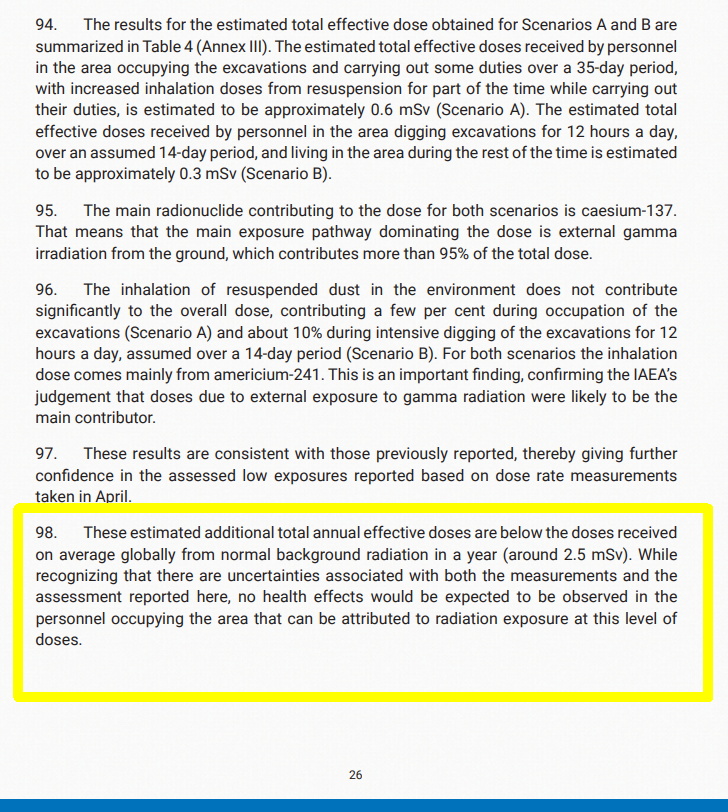JUST IN: The @iaeaorg has made its report on the Zaporizhzhia nuclear power plant public! I'll be diving in shortly...
iaea.org/sites/default/…
Holy moly, the plant was shelled while the @iaeaorg team was visiting. The team had to shelter in the ground floor of the admin building. They also witnessed lots of damage.

These photos are just wow... That artillery could shatter the windows of the walkway to reactor 6. That's a close strike. And this hole in the roof of the auxiliary building. We now know, thanks to the IAEA that the building housed spent and fresh nuclear fuel.


The IAEA also directly observed the presence of Russian military vehicles in the Unit 1 and 2 turbine halls and under the overpasses. The also saw ROSATOM officials at the plant (contrary to reports that they may have been evacuated ahead of the visit).


And those ROSATOM officials aren't helping, according to the agency. They fear that the presence of the Russians could "interfere with normal lines of operational command authority." The report also says that the Ukrainian staff is not doing well.

More details on staffing, the plant's security staff is operating at 40% (presumably because many of them had fought the initial Russian occupation and fled). Overall staffing is 907 instead of the normal 1230 (73%) but the fire brigade is only 80 of 150 (53%).

Critical information about the Emergency Diesel Generators (EDGs) in this section. There are 20 EDGs on site, & it looks like 17 have been used for cooling at some point. The current fuel inventory can last for 10 days. Something a lot of people have been wondering about.

(Also in that section a reference to operating Unit 6 in "island mode" to power its own subsystems. Anyone who knows anything about how this works, DM me! So curious about this whole island mode configuration).
Two really worrying things in the emergency preparedness section: ❌ The station no longer has a clear line of communication with the public to declare an emergency. ❌ The operators have been kicked out of their on-site emergency center by the Russian military.

⬆️The above shows why human and physical systems are needed to keep a nuke plant safe. The emergency operations center has things like independent power and ventilation that would be essential in a meltdown. But also essential are clear lines of communication to the public.
Quick break to marvel at the @iaeaorg's "simple" traffic light system that includes bifurcated traffic lights and a light that is simultaneously 🔴and 🟢. It's this kind of risk communication that keeps me in business as a public radio journalist.

@iaeaorg Oh WHAT!?! There's a bonus Chernobyl section in which the @iaeaorg evaluated the risk Russian troops took by digging into the nuclear site's contaminated soil... The IAEA finds that the soldiers probably didn't get a significant radiation dose form their time in the zone.

@iaeaorg For more on the Russian's adventure, here's a story we did a few months back, reaching a similar conclusion: ✅Probably little to no additional health risk. ❌Still dumb to do.
npr.org/2022/04/07/109…
OK, there's a brief discussion of other 🇺🇦☢️ facilities, but I don't see too much in there (RIP Kharkiv subcritical Neutron Source).
The next thing really is a discussion of equipment the IAEA member states are supplying 🇺🇦 including: ✅ 370 Dosimeters ✅ 150K pieces of PPE ✅ 200K packs of KI tablets.

The final section of the report is on safeguards. This is what the IAEA is ACTUALLY supposed to do day-to-day: keep track of nuclear material at these plants and make sure nobody's diverting/stealing it. It says it's been able to do an ok job everywhere except Zaporizhzhia.
And that's pretty much it for my first pass through this report. Lots of interesting details we didn't have before. Feel free to drop anything below you think I may have missed! /END 🧵
